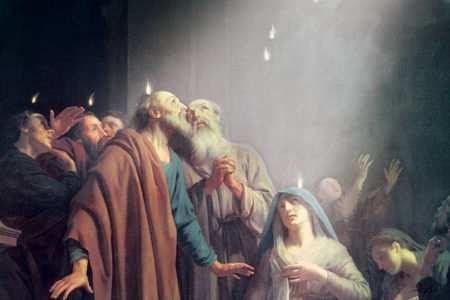The Emerging Church: What Is It?
The Israelites were the beneficiaries of the first fast-food delivery service. Each morning during their 40 years in the wilderness (except on the Sabbath), a white substance tasting like “wafers made with honey” arrived from heaven and covered the ground (Ex. 16:31). At the end of the day (except on the Sabbath), anything left over became rank and infested with worms. In all that time, the Israelites never did know what the substance was. So they called it manna, Hebrew for “what is it?”
Like the manna that suddenly appeared to the children of Israel, so a new movement has appeared among evangelicals today. Many churches are aware of its presence and, in many instances, have adopted some of its novel worship styles. This movement—or as it is sometimes referred to, “conversation”*—is called the emerging church (hereafter referred to as EC). (An asterisk indicates the word is defined in the glossary) Yet when most evangelicals hear the term, they ask, as did the children of Israel, “What is it?”
Unfortunately, the question is far easier to ask than it is to answer. If you search the Internet for “emerging church,” be prepared for an overwhelming list of Web sites, discussion groups, and blogs.
Brian McLaren, considered the “dean of EC,” is the founding pastor of Cedar Ridge Community Church in Spencerville, Maryland, and was listed by Time in 2005 as one of the 25 most influential evangelicals in America. The subtitle of his book A Generous Orthodoxy illustrates the difficulty in grasping an understanding of the movement. It reads, “Why I am a missional + evangelical + post/protestant + liberal/conservative + mystical/poetic + biblical + charismatic/contemplative + fundamentalist/calvinist + anabaptist/anglican + methodist + catholic + green + incarnational + depressed-yet-hopeful + emergent + unfinished Christian.”
McLaren makes the point that his brand of Christianity is like Teflon: nothing sticks. EC has no single model; instead it has “hundreds and thousands of models.”1 What is it, then? Will it benefit the church as fresh manna benefited the Israelites? Or will it be harmful, like the manna that rotted?
A Postmodern Phenomenon
According to the George Barna research group, one-third of America’s adults are unchurched.2 Barna projects that by 2025, only 5 percent of American Christians will express their faith through the local church.3 Young people are the least likely to describe themselves as Christian, and church attendance is declining by generation.4 The church undoubtedly is losing ground, a fact that should concern every Christian.
ECers believe the reason for this situation, at least in part, is because of a shift in the 1990s in epistemology* (how people know things or how we think they know things). Until then, modernism* was the worldview. The epistemology in modernism holds to a single moral standard and to absolute truth, science, and logic. Postmodernists* (post literally means “coming out of”) hold a different view: “What we ‘know’ is shaped by the culture in which we live, is controlled by emotions and aesthetics and heritage, and in fact can only be intelligently held as part of a common tradition, without overbearing claims to being true or right.”5
Several pastors and concerned evangelicals noticed this apparent shift in culture and began to talk about changes they believed the church needed to make to reach this new generation. The concern echoed across the Atlantic into Great Britain; and the discussion was enlarged, extending into Australia and New Zealand. What emerged was an ongoing conversation,* the term most ECers prefer. Because of these different views and ideas, it is impossible to make a corporate statement concerning the emerging church and have it be true of all those involved. ECers themselves would classify the conversation differently, depending on who was talking. There is no central office or specific spokesperson. There are, however, many popular and recognized ECers. There is also a Web site called Emergent Village.*
From Seeker to Savvy
The popular model of the evangelical church at the close of the modernist era was the seeker-sensitive church. Started early in the 1980s primarily by baby boomers (people born between 1946 and 1964), its philosophy of ministry was to meet “felt needs.” Pastors wanted church to be attractive to a generation that was disillusioned with traditional church. Pews were replaced with theater seats. Choirs and hymnals gave way to worship teams singing praise songs. Organs were shut down, and drums and electric guitars were turned on. Casual dress replaced coats, ties, and dresses. Sermons were no longer preached behind large wooden pulpits. And the pastor, wired for sound, placed his Bible on a clear acrylic stand and used a computer to deliver his PowerPoint® “presentation.”
This style appealed to baby boomers, and these congregations grew quickly. As they grew, so did their facilities. Soon the church became a one-stop shop for spiritual and physical needs. Restaurants, cafés, bookstores, gyms, and children’s playgrounds all had their niches on the church “campus.”
Worship was performed in front of the audience, and the audience loved it. The atmosphere looked corporate; the staff, professional yet down to earth. The messages were less preachy, less doctrinal, and more related to everyday life. Bible, missions, and prophecy conferences were not on these churches’ calendars.
Then a new generation arose called Generation X. The Xers are quite different from their baby-boomer parents. They are postmodern, meaning globally savvy through constant exposure to “global news, global fashion, global music and global religions,” all transmitted instantly through our advanced technology.6 They weren’t raised with TV, like their grandparents—or even cable, like their parents. They have satellite; TiVo®; and the ubiquitous, interactive, online communities of MySpace and Facebook. They meet each other over the Internet, connecting regularly with people around the world.
They don’t merely hear about wars and world conflicts on the evening news or read about them in the newspapers; they watch them happen live while eating dinner. They not only watch movies, they make their own using their computers. They don’t just collect music; they carry their entire, massive collections with them wherever they go on tiny, computerized marvels called iPods.
What most Generation Xers know about Christianity comes from what others say about it. Their views are shaped by the mass media and high-powered celebrities who portray Christianity negatively. They believe Christians are close-minded, intolerant, and dangerous. For the Xers, objective truth is relative; and Christians who spew statements about absolutes are bigoted and racist.
Although seeker-sensitive churches still thrive, this generation sees them as impersonal and materialistic—mirrors of corporate America, emphasizing buildings, money, and people. They say they want to see compassion, care, and concern and claim they “feel disenfranchised with nowhere to look.”7
The emerging church seeks to com-bat that feeling. It wants to create an atmosphere of acceptance and a sense of welcome. The three Cs of EC are “celebrating, connecting, and coaching.”8
EC congregations tend to be smaller and more intimate than seeker-sensitive or mega churches. Many Xers feel disconnected by precisely timed, well-tuned “worship hours.” They want to participate and feel connected. So EC churches deconstruct* worship time and refashion it into a more “meaningful” environment. Often that means meeting in a darkened room lit only with candles. Wafting through the air might be finely scented incense to heighten individual senses. Various religious symbols—such as icons, statues, and crosses—adorn the room, making the atmosphere more worshipful for Xers. The goal is to create participation in worship.
Many EC participants de-emphasize preaching a Bible message from a pulpit and opt to use the time for individual worship by setting up stations featuring a variety of activities. One station might feature a table for journaling; another might prompt quiet meditation and provide headphones so the worshiper can listen to quiet, soothing music. Other stations might feature art or poetry. Experiencing Jesus and connecting with a community of worshipers is the way to reach postmodernists, according to many in the EC.
EC’s Nonconfrontational Position
Since EC likes dialogue, those within it say, “All theology will remain a conversation about the Truth who is God in Christ through the Spirit, and about God’s story of redemption at work in the church. No systematic theology can be final.”9 One EC writer put it this way: “This is what I believe, but I could be wrong. What do you think? Let’s talk.”10 The emergent church is extremely interested in the metanarrative,* or “the big picture.” Much of the Bible, say ECers, is a series of stories told from a particular perspective. There is reluctance to emphasize absolutes. A secular writer, commenting on the EC movement and postmodern Christianity, summed things up this way: “What makes a postmodern ministry so easy to embrace is that it doesn’t demonize youth culture—Marilyn Manson, ‘South Park,’ or gangsta rap, for example—like traditional fundamentalists. Postmodern congregants aren’t challenged to reject the outside world.”11 (Marilyn Manson [real name, Brian Warner] performs in garish, demonic-looking costumes and feminine makeup and sings obscenities as lyrics. Gangsta rap is obscenity and violence spoken to a beat.)
Emergents are less likely to confront culture when it clashes with biblical truth. Tony Campolo, for example, explained to a reporter why he wrote his book Speaking My Mind: “My purpose in writing the book was to communicate loud and clear that I felt that evangelical Christianity had been hijacked. When did it become anti-feminist? When did evangelical Christianity become anti-gay? When did it become supportive of capital punishment? Pro-war? When did it become so negative towards other religious groups?”12
Keep in mind that, because of the fluidity of the movement, not all ECers believe this way. But much of the conversation tends in this direction.
Sometimes EC’s strong desire to be creative in worship intimidates more traditional people. Dr. David McLeod, dean of systematic theology at Emmaus Bible College in Iowa, stated it well: “It’s not the bells and whistles of EC that concern me. It is the way they handle the Bible. It [the Bible] is the Word of God, and it is absolutely true.”
Acts 2:42 and Colossians 3:16 provide absolutes in worship while allowing flexibility. It is fair to say that one can be true to the text without creating a cookie-cutter church.
Those within EC encourage believers to live an authentic, Christlike life. A common expression today is “Let’s get real.” It is also a wonderful exhortation for followers of Christ, for God indeed looks at the heart. The apostle Peter said, “In truth I perceive that God shows no partiality” (Acts 10:34). And the book of Hebrews urges us to look “unto Jesus, the author and finisher of our faith” (12:2).
The emergent church is probably here to stay. We should be familiar enough with it to see if it departs from the fundamentals of the faith. A thought to ponder is this: If the culture changes, does the message have to change? How far does the messenger go to adjust his delivery? Jesus said, “I will build My church, and the gates of Hades shall not prevail against it” (Mt. 16:18). Each local assembly must be evaluated against the Word. If a church rightly divides the Word and preaches truth while simply adjusting the “bells and whistles,” it is like the sustaining manna for the children of Israel. If, however, in the name of culture, it adopts humanistic elements and departs from the truth of the Word, then it will be like spoiled manna that reeks with a terrible stench.
ENDNOTES
- Dan Kimball, The Emerging Church (Grand Rapids: Zondervan, 2003), 14.
- “Unchurched Population Nears 100 Million in the U.S.,” The Barna Group, March 19, 2007 <barna.org/FlexPage.aspx?Page=BarnaUpdate&BarnaUpdateID=267>.
- Darren King, “An Ode to the Local Church: 10 Things to Love About Congregational Gathering” <precipicemagazine.com/ode-local-church.htm>.
- Kimball, 48.
- A Carson, Becoming Conversant With the Emerging Church (Grand Rapids: Zondervan, 2005), 27.
- Kimball, 59.
- Author’s interview with Michael J. Leary, Ph.D. candidate in New Testament, University of Edinburgh, April 6, 2007.
- Carson, 38.
- Scot McKnight, “Five Streams of the Emerging Church,” February 2007 <christianitytoday.com/ct/2007/february/11.35.html>.
- Ibid.
- Lori Leibovich, “Generation: A Look Inside Fundamentalism’s Answer to MTV: The Postmodern Church,” July/August 1998 <motherjones.com/news/feature/1998/07/leibovich.html>.
- Laura Sheahen, “‘Evangelical Christianity Has Been Hijacked’: An Interview With Tony Campolo,” July 30, 2004 <beliefnet.com/story/150/story_15052_1.html>.







